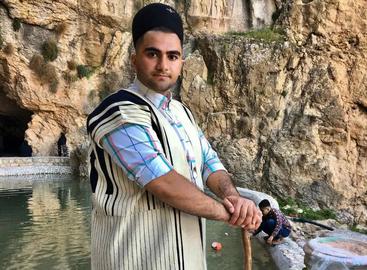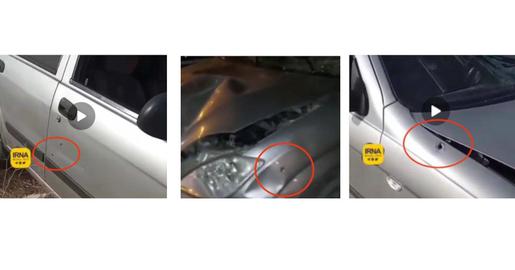Pouya Molaei-Rad, 19, a cousin of Kian Pirfalak's mother, Mahmonir Molaei, met a tragic fate on the evening of June 11.
Pouya was killed by gunfire from Iranian security forces, leaving family and friends devastated by the untimely loss.
The incident was made all the worse because June 11 marked the tenth birthday of Kian Pirfalak, a young soul whose life was cut short on November 16, 2022, during nationwide protests sparked by the death of Mahsa Amini in police custody.
In remembrance of Kian, a poignant gathering was taking place at his gravesite, where loved ones assembled to pay their heartfelt respects.
But harassment and attacks by security services during the ceremony saw Pouya Molaei-Rad, a student, struck by gunfire at the cemetery in the village of Parchestan, located in the city of Izeh, Khuzestan province.
As news of Pouya’s death spread across the nation, the propaganda machinery of the Islamic Republic swiftly sprang into action, releasing the government's account of the incident.
This preemptive dissemination aimed to establish their narrative before any alternative perspectives could emerge. But Iranian citizens tend to view official news with scepticism. The repression of independent media and journalists within the country, meanwhile, hampers their ability to authenticate news disseminated by the government.
Despite the Islamic Republic’s 44-year endeavor to control the narrative, cracks have begun to appear, exposing overt contradictions that align with their own interests. The erosion of trust continues as Iranian citizens question the authenticity and impartiality of the narratives presented by the government.
What was the Iranian Government’s Version?
At 730pm on June 11, the following news was initially reported and subsequently republished by most media outlets in the country: "A police officer in Izeh has been martyred. This dedicated officer was fulfilling his duty to maintain security when he was tragically struck by a car, leading to his martyrdom."
An hour and a half later, Yar Mohammad Resalati, the prosecutor of Izeh, addressed the media, stating: "Tonight, at one of the city's entry points, a car with a distinct identity deliberately and recklessly targeted the officers stationed at the checkpoint. As a result, one of our officers lost his life at the scene, sacrificing himself in the line of duty."
The Izeh prosecutor also confirmed, for the first time, that the driver of the car was fatally shot by officers.
The government's desired narrative also circulated through various Telegram channels and Twitter accounts.
To create a more coherent narrative, the propaganda machinery of the Islamic Republic began fabricating an Instagram story hours before the incident, claiming that Pouya intentionally hit a security agent with a car and then collided with a soldier, causing agents to open fire.
In an attempt to lend credibility to this narrative, an image titled "Pouya Molaei-Rad's Instagram story" was forged by the propaganda apparatus. However, this story did not actually exist on Pouya's genuine Instagram account, and the profile picture used was also different from his real profile.
Official media quickly picked up and republished this narrative, with news agencies such as Fars, Tasnim, and Mizan, as well as websites like Mashreq, providing more detailed accounts.
However, these details revealed several glaring contradictions between the government's narrative and reality.
According to the official story, security agents shot Pouya Molaei-Rad while he was allegedly attempting to confront other agents from the driver's seat of the car.
In the published images of Pouya's body in the morgue, most of the gunshot wounds were concentrated in his upper torso and the right side of his body.
This indicates that the police must have fired from the right side of the car towards the driver's seat.
However, based on the published images, the bullets hit the upper part of the body, specifically the area below the shoulder and above the kidney.
The height of the seat in various models of Tiba cars, which Pouya was driving, ranges between 50 and 60 cm from the ground.
Assuming Pouya's height is approximately the average height of Iranian men, i.e. 175 cm, the location of the gunshot wounds would be approximately 70 to 90 cm above the ground.
This raises the question: Why did the assailant(s), instead of aiming directly at a height of about 130 cm from the ground, hold the gun's barrel downward to target the vital organs of the car's driver? Alternatively, why did they not lower the angle of the gun barrel to target only his legs, preventing further action, instead of delivering a fatal shot?
The answer to this question can be found in the initial official statement from the Izeh Prosecutor's Office, where the emphasis was placed on the name of the deceased driver: "A vehicle driver with a known identity."
Additionally, the IRNA news agency, quoting the deputy police chief of Khuzestan, reported that during Kian's birthday commemoration and a public gathering at his gravesite, one police officer was killed due to the "intentional collision" of a car with a "known identity."
This emphasis suggests that the assailant(s) were aware of the driver's identity and likely knew about his relationship with Kian Pirflak and Mahmonir Molaei
Photos of Pouya’s Car Expose Official Lies
The official media outlet of the Islamic Republic, the Islamic Republic News Agency or IRNA, released images of Pouya's car in an attempt to bolster the government's line regarding the events of the evening of June 11.
But the publication of these pictures only served to further undermine the credibility of the Islamic Republic's narrative.
In the images, it is evident that four bullets struck Puya's car. While two bullets hit the front of the car, likely causing damage to the engine, the two bullets that hit the right door were fired from an extreme angle and at a downward trajectory.
These shots cannot have reached the driver's body on the right side of the car, especially considering that, according to local sources, at least six bullets hit Pouya's body.
For a straightforward comparison, one can examine the published images of the car carrying the Kian family, which was also a Tiba, on the night of on November 16, 2022.
These pictures of Kian's family car have been widely circulated in official media of the Islamic Republic. The bullets visible in these images caused the death of Kian and inflicted severe injuries upon his father, both of whom were seated on the left side of the car, i.e., the driver's seat and the seat behind it.
On the contrary, the two main bullets fired at Pouya's car struck the side opposite to where he was seated, and at a lower angle.
Understanding the Family’s Version
An hour after the news of Pouya's death, his sister, Behrokh, provided a different account of the incident.
According to her, after the collision between Pouya's car and a member of the security forces, he exited the vehicle and surrendered. However, he was then tied to a pole by other officers.
This narrative sheds light on why the bullets struck Pouya's upper body and did not hit his car.
In an attempt to counter this revelation from Pouya's sister, the government's propaganda claimed that "security forces" were not present at the turn of the road.
While it may be challenging to pinpoint the exact location of the security forces on the evening of June 11, maps of the two routes leading to the village from Izeh suggest that it was possible for the agents to conceal themselves around the road's turns.
Another claim made by the police force regarding the presence of security agents in that area, supposedly to prevent any disruptions to Kian's birthday ceremony, is contradicted by published reports detailing the escalating pressures on Kian's family. These reports also include threats made against Mahmonir Molaei by agents, also reported by IranWire; she was told that her husband and child would be killed if a birthday commemoration for Kian took place.
The Government’s Attempt to Discret a Mourning Mother
Simultaneous to the news of Pouya's death, both the media and supporters of the Islamic Republic launched a fierce attack against Kian Pirfalak’s mother, Mahmonir Molaei, on social media platforms.
Noor News, a media outlet closely affiliated with the Supreme National Security Council, identified Mahmonir Molaei as the "main instigator" behind the killing of a police officer. They claimed that the agent, who government-affiliated media outlets allege died due to the intentional impact of Pouya's car, was targeted because of her actions.
Telegram channel Sabrin News, which has close ties to the Islamic Revolutionary Guard Corps (IRGC), labeled Kian's mother as "one of the main factors in creating a terrorist atmosphere." Additionally, Tasnim news agency, also affiliated with the IRGC, accused her of becoming a "pawn for rioters and vandals" and of supporting terrorists.
Fars News Agency published several reports criticizing Mahmonir Molaei, while Mehdi Mohammadi, an advisor to the speaker of the parliament, tweeted that the "Izeh project was premeditated."
He claimed that at the "core of the project was a woman who was willing to trade anything, including her child's blood."
In the months following her son's death, Mahmonir Molaei vehemently criticized the Islamic Republic and demanded justice for her son’s killers. Recently, she posted a photo of her cousin on her Instagram page, giving him the nickname Javidnam or immortal.
The recent threats against Mahmonir Molaei, coupled with the security encounters faced by other petitioning families, have raised concerns that security institutions may seek further retaliation against her and the Pirflak family.


























comments